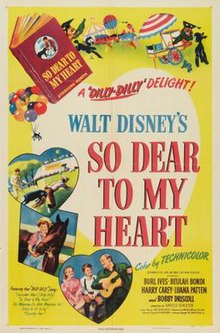So Dear to My Heart
| So Dear to My Heart | |
|---|---|
 Theatrical release poster | |
| Directed by | Harold D. Schuster Hamilton Luske |
| Written by | Ken Anderson John Tucker Battle Marc Davis Bill Peet Maurice Rapf Ted Sears |
| Produced by | Walt Disney Perce Pearce |
| Starring | Bobby Driscoll Luana Patten Beulah Bondi Burl Ives |
| Cinematography | Winton C. Hoch |
| Edited by | Lloyd L. Richardson Thomas Scott |
| Music by | Paul Smith |
Production company | |
| Distributed by | RKO Radio Pictures, Inc. |
Release dates | |
Running time | 82 minutes |
| Country | United States |
| Language | English |
| Budget | $1.5 million[2] |
So Dear to My Heart is a 1949 feature film produced by Walt Disney, whose world premiere was in Indianapolis on January 19, 1949, released by RKO Radio Pictures. Like 1946's Song of the South, the film combines animation and live action. It is based on the Sterling North book Midnight and Jeremiah.
Plot
Set in Indiana in 1903, the film tells the tale of Jeremiah Kincaid (Bobby Driscoll) and his determination to raise a black-wool lamb that was once rejected by its mother. Jeremiah names the lamb Danny for the famed race horse, Dan Patch (who is also portrayed in the film). Jeremiah's dream of showing Danny at the Pike County Fair must overcome the obstinate objections of his loving—yet tough—grandmother Granny (Beulah Bondi). Jeremiah's confidant, Uncle Hiram (Burl Ives), is the boy's steady ally. Inspired by the animated figures and stories, the boy perseveres.[3]
Cast
- Bobby Driscoll as Jeremiah "Jerry" Kincaid
- Luana Patten as Tildy
- Burl Ives as Uncle Hiram Douglas
- Beulah Bondi as Granny Kincaid
- Harry Carey as Head Judge at County Fair
- Raymond Bond as Pete Grundy, Storekeeper
- Walter Soderling as Grampa Meeker
- Matt Willis as Mr. Burns, Horse Trainer
- Spelman B. Collins as Judge
- Bob Haymes as Singer Bob Haymes
Voices
- John Beal as Adult Jeremiah/Narrator
- Ken Carson as The Owl
- Bob Stanton
- The Rhythmaires as Vocal Ensemble
Awards and honors
The film was nominated for the Academy Award for Best Original Song for Burl Ives's version of the 17th-century English folk song "Lavender Blue," but lost to "Baby, It's Cold Outside" from Neptune's Daughter.
Bobby Driscoll received a special Juvenile Award from the Academy, honoring him as "the outstanding juvenile actor of 1949".[4] (In addition to So Dear to My Heart, he had garnered critical acclaim for his dramatic performance in the RKO melodrama The Window.)
The film is recognized by American Film Institute in these lists:
- 2004: AFI's 100 Years...100 Songs:
- "Lavender Blue" – Nominated[5]
Production
The train depot in the film was later relocated to Ward Kimball's Grizzly Flats Railroad in his backyard. After the railroad closed, John Lasseter relocated it to his property.
Release
The film was re-released in 1964 and earned an estimated $1.5 million in rentals in North America.[6]
So Dear to My Heart was not released on home video until 1986. It was then re-released in 1992 and released on video in 1994 as part of the Walt Disney Masterpiece Collection. The film was originally planned for a US DVD release as part of the Walt Disney Gold Classic Collection, but was cancelled, with no particular reason given. Six years after seeing a region 2 DVD release, it was released in the US on DVD in July 2008 as a Disney Movie Club Exclusive.
See also
References
- ^ a b "So Dear to My Heart: Detail View". American Film Institute. Retrieved May 13, 2014.
- ^ Variety 18 February 1948 p 14
- ^ Lockhart, Jane. "Looking at Movies: So Dear to My Heart". The Rotarian. February 1949, p.36.
- ^ "22nd Academy Awards". Oscars.org. Archived from the original on July 6, 2011. Retrieved July 6, 2011.
{{cite web}}: Unknown parameter|deadurl=ignored (|url-status=suggested) (help) - ^ "AFI's 100 Years...100 Songs Nominees" (PDF). Retrieved 2016-08-05.
- ^ "Big Rental Pictures of 1964", Variety, 6 January 1965 p 39. Please note this figure is rentals accruing to distributors not total gross.
External links
- 1949 films
- Walt Disney Pictures films
- 1948 films
- American drama films
- 1940s drama films
- Films based on children's books
- Films set in 1903
- Films set in Indiana
- American animated films
- American films
- Films based on American novels
- Films directed by Hamilton Luske
- 1940s American animated films
- Films produced by Walt Disney
- Films produced by Perce Pearce
- RKO Pictures films
- Film scores by Paul Smith (film and television composer)
- Films with live action and animation
